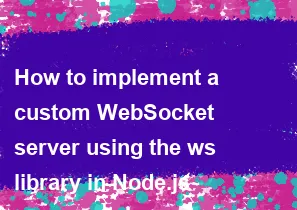How to implement a custom WebSocket server using the ws library in Node.js

To implement a custom WebSocket server using the ws library in Node.js, you can follow these steps:
Install the
wslibrary: Make sure you have Node.js installed on your machine. You can then use npm to install thewslibrary:bashnpm install wsCreate a WebSocket server: Create a new file (e.g.,
websocket-server.js) and implement the WebSocket server using thewslibrary:javascriptconst WebSocket = require('ws'); const server = new WebSocket.Server({ port: 3000 }); server.on('connection', (socket) => { console.log('Client connected'); // Handle messages from clients socket.on('message', (message) => { console.log(`Received message: ${message}`); // Broadcast the message to all connected clients server.clients.forEach((client) => { if (client !== socket && client.readyState === WebSocket.OPEN) { client.send(message); } }); }); // Handle disconnection socket.on('close', () => { console.log('Client disconnected'); }); }); console.log('WebSocket server listening on port 3000');This code creates a WebSocket server listening on port 3000. It logs messages when a client connects, disconnects, and sends a message. It also broadcasts messages to all connected clients.
Run the WebSocket server: Save the file and run it using Node.js:
bashnode websocket-server.jsThe WebSocket server will start listening on port 3000.
Create a WebSocket client: You can create a simple WebSocket client to test the server. Here's an example using JavaScript in an HTML file (
websocket-client.html):html<!DOCTYPE html> <html lang="en"> <head> <meta charset="UTF-8"> <meta name="viewport" content="width=device-width, initial-scale=1.0"> <title>WebSocket Client</title> </head> <body> <input type="text" id="messageInput" placeholder="Type a message"> <button onclick="sendMessage()">Send</button> <ul id="messages"></ul> <script> const socket = new WebSocket('ws://localhost:3000'); socket.addEventListener('open', (event) => { console.log('Connected to WebSocket server'); }); socket.addEventListener('message', (event) => { const messagesElement = document.getElementById('messages'); const li = document.createElement('li'); li.textContent = event.data; messagesElement.appendChild(li); }); function sendMessage() { const inputElement = document.getElementById('messageInput'); const message = inputElement.value; socket.send(message); inputElement.value = ''; } </script> </body> </html>Open the HTML file in a web browser. You can now type messages in the input field, click the "Send" button, and see the messages being broadcasted to all connected clients.
This example provides a basic implementation of a WebSocket server using the ws library in Node.js. You can extend and customize it based on your specific requirements.
-
Popular Post
- How to optimize for Google's About This Result feature for local businesses
- How to implement multi-language support in an Express.js application
- How to handle and optimize for changes in mobile search behavior
- How to handle CORS in a Node.js application
- How to use Vue.js with a UI framework (e.g., Vuetify, Element UI)
- How to configure Laravel Telescope for monitoring and profiling API requests
- How to create a command-line tool using the Commander.js library in Node.js
- How to implement code splitting in a React.js application
- How to use the AWS SDK for Node.js to interact with various AWS services
- How to use the Node.js Stream API for efficient data processing
- How to implement a cookie parser middleware in Node.js
- How to implement WebSockets for real-time communication in React
-
Latest Post
- How to implement a dynamic form with dynamic field styling based on user input in Next.js
- How to create a custom hook for handling user interactions with the browser's device motion in Next.js
- How to create a custom hook for handling user interactions with the browser's battery status in Next.js
- How to implement a dynamic form with dynamic field visibility based on user input in Next.js
- How to implement a dynamic form with real-time collaboration features in Next.js
- How to create a custom hook for handling user interactions with the browser's media devices in Next.js
- How to use the useSWRInfinite hook for paginating data with a custom loading indicator in Next.js
- How to create a custom hook for handling user interactions with the browser's network status in Next.js
- How to create a custom hook for handling user interactions with the browser's location in Next.js
- How to implement a dynamic form with multi-language support in Next.js
- How to create a custom hook for handling user interactions with the browser's ambient light sensor in Next.js
- How to use the useHover hook for creating interactive image zoom effects in Next.js